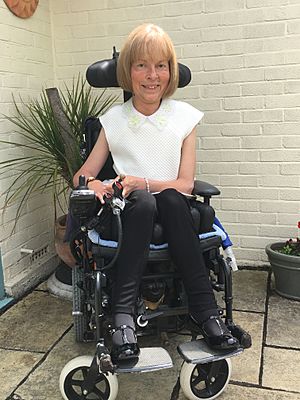Jane Campbell, Baroness Campbell of Surbiton facts for kids
Quick facts for kids
The Baroness Campbell of Surbiton
|
|
|---|---|

Baroness Campbell in 2016
|
|
| Member of the House of Lords Lord Temporal |
|
| Assumed office 30 March 2007 Life peerage |
|
| Personal details | |
| Born |
Jane Susan Campbell
19 April 1959 London, England |
| Political party | Crossbench |
| Known for | Campaigner and adviser for disability reforms |
| Website | https://baronesscampbellofsurbiton.uk/ |
Jane Susan Campbell, Baroness Campbell of Surbiton, DBE (born 19 April 1959) is a British disability rights campaigner and a life peer in the House of Lords. She was Commissioner of the Equality and Human Rights Commission (EHRC), and served as the Chair of the Disability Committee which led on to the EHRC Disability Programme. She was the former Chair of the Social Care Institute for Excellence (SCIE). She was a Commissioner at the Disability Rights Commission (DRC).
Contents
Early life
Campbell grew up in New Malden. Her father, Ron, was a heating engineer and her mother, Jesse, was a window dresser in a gown shop. At the age of nine months Campbell did not have the strength in her neck muscles to hold her head up, and exhibited little movement by the age of one year. Her mother consulted the family doctor who referred her to the local Kingston Hospital.
She was subsequently referred to Great Ormond Street Hospital where she was diagnosed with spinal muscular atrophy and given a prognosis that she would not live to reach the age of two years; however, it was her younger sister, Sally, who died from the same disease before that age. As a child she was prone to getting severe chest infections, which occurred two or three times per year, sometimes requiring hospitalisation.
Education
Campbell went to a segregated school for disabled children where academic achievement was not the top priority. Her best friend, who had a hole in the heart, died at the age of 13 years. She left school at the age of 16 years with no qualifications and hardly able to read or write, but she nevertheless regarded herself as quite intelligent.
In 1975 she enrolled at Hereward College, Tile Hill, Coventry; a special college for disabled students where there was an academic environment, and where she was generally able to enjoy the life-style of an ordinary teenager. While there she gained six O-levels and three A-levels within three years. From Coventry she went to Hatfield Polytechnic, and then became an MA at the University of Sussex with a dissertation on Sylvia Pankhurst.
Career
In 1984 she started her career in local government as Equal Opportunities Liaison Officer, in Greater London Council (GLC) followed by Disability Training Development Officer role, London Boroughs Disability Resource Team (LBDRT) where she ran the Disability Equality and Awareness Training unit.
In 1987 she was appointed as a Principal Disability Advisor for London Borough of Hounslow. After a year she returned to the LBDRT as Director of Training were she remained until she established her own disability consultancy in 1994. In the early 1990s she co-chaired the British Council of Disabled People (BCODP) with Lucille Lusk.
In 1996 there was a spin-out organisation from BCODP - the National Centre for Independent Living (NCIL) - which she co-founded and co-directed with Frances Hassler. Campbell worked at NCIL for six years before being appointed by the Minister for Social Care to chair the Social Care Institute for Excellence (SCIE).
Also in 1996 she co-authored a textbook entitled Disability Politics, and in 2001 she was appointed a Dame Commander of the Order of the British Empire (DBE) in the Queen's Birthday Honours.
In 2003, Campbell was awarded an honorary doctorate in law from Bristol University and another in social sciences from Sheffield Hallam University.
She was Commissioner of the Disability Rights Commission until it was wound up in October 2006.
From 2006 to 2008, she was commissioner of the Equality and Human Rights Commission (EHRC). She also served as chair of the Disability Committee which led on to the EHRC Disability Programme.
In February 2007, it was announced by the House of Lords Appointments Commission that she would be made a life peer and would sit as a crossbencher. Her peerage was gazetted as Baroness Campbell of Surbiton, of Surbiton in the Royal Borough of Kingston upon Thames on 30 March 2007.
In her campaigning record, items of public note include the creation and later closure of the Independent Living Fund (ILF), the creation of the Community Care (Direct Payments) Act 1996, the loss of some disabled people's welfare benefits, the disproportionate impact of the COVID-19 pandemic on disabled people's lives, and attempts in Parliament and the appeal courts to change the law on assisted dying as it impacts on disabled people.
Personal life
Campbell met her first husband, Graham Ingleson, at Hereward College; they married when she was 27 years old. He was a haemophiliac, and six weeks before the wedding they discovered that he had contracted HIV from a blood transfusion, from which he later died. She currently lives in Tolworth with her second husband Roger Symes, a businessman.
Because of her physical weakness Campbell requires help to do almost everything and needs a ventilator to help her breathe at night. She uses an electrically powered wheelchair and has a computer on which she types with one finger. As of 2009, she received a direct payment from the local authority for her care needs, which enabled her to employ five female carers to help her with the routine activities of daily living.

